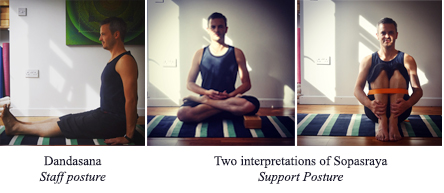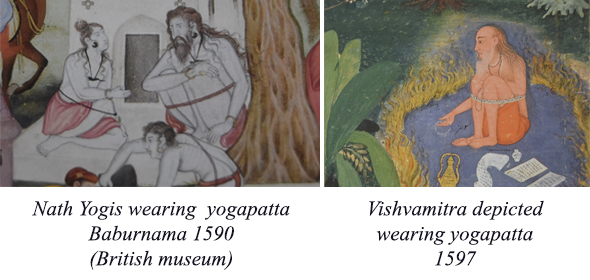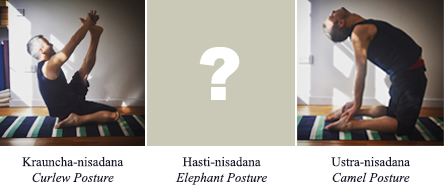
By James Russell.
Yoga classes are often characterised by an emphasis on the performance of physical postures, referred to collectively by the Sanskrit term ‘asana’.
“Asana derives from the verbal root ‘as’, meaning ‘to be present; to exist; to inhabit, dwell in; to make one’s abode in…; to sit quietly, abide, remain… to continue in any situation.” – (Mikel Burley)
There has recently been much speculation as to origin of these postures. Some academics contend that large portions of contemporary yoga are modern innovations, appropriated from gymnastics and Victorian bodybuilding in the late 19th and early 20th century. Meanwhile, others are adamant that the postures belong to a much older tradition. For many yoga practitioners, asana is regarded as a timeless expression of innate human physicality, beyond the confines of tradition and localised culture.
Because yoga is in essence an oral tradition, and literacy in India was for centuries uncommon, it is difficult to chart the development of yoga’s vast history purely through textural analysis. Also, a great many texts have been lost or remain untranslated. The texts that we have offer, at best, a bread-crumb trail. However, if we follow the trail carefully, we can gain some fascinating insights into the evolution of the practice.
Early yoga texts such as the Bhagavad Gita (200BCE) and Yoga Sutra (350 CE) , typically frame asana within the context of establishing a simple seated position in order to meditate. It is within the later tradition of ‘Hatha Yoga’, which flourished between the 12th and 18th centuries, that asana takes on a more significanct role and we find a variety of postures. Whilst there is no doubt that many of the yoga postures in popular usage today can be traced back to this later Hatha path, it remains unclear as to whether an earlier asana tradition existed and we find a difficult gap of around 1000 years between the Yoga Sutra’s one seated asana and the variety of asana found in early Hatha texts.
Hatha Yoga – The Yoga of Force
“Prior to everything, asana is spoken of as the first part of hatha yoga. Having done asana one gets steadiness of body and mind.” – (Hatha Pradipika 1.17)
Originally Hatha Yoga was a synthesis of Tantra and Asceticism, that consolidated a broad spectrum of physical and energetic practices aimed at the containment of subtle energy and the ascension of Kundalini Shakti. Within this approach, asana was expanded out from a seated position to encompass “any bodily posture that may be maintained for a prolonged period.” (Burley.) A variety of Hatha techniques were codified in texts from around the 11th century onwards, that were largely plagiarised from earlier (as yet unpublished) Tantric shastras dating from the 6th century onwards. Early Tantric texts typically denote an ‘asana’ as a ‘throne’ upon which a Deity is installed. Postures are also referred to as ‘Karana’ suggesting movement and ‘Pitha’ indicating a seat.
Although mediaeval Hatha texts allude to vast numbers of postures and 84 classic asana, most describe or list a handful those asana and ‘Mudra’ (energetic seals) that were considered to be particularly important:
“There are as many postures as there are species of beings. Only Maheshvara (Lord Shiva) knows all their varieties. Of the 8400,000 (asana) one for each 100,000 has been mentioned.
Thus Shiva created eighty four seats (pitha) for Yogins.” – (Goraksha Paddhati 1.8 – 1.9)
Perhaps the most famous Hatha text is the Hatha Pradipika (Svatmarama 1450), in which for the first time, asana is identified as a key component of the Hatha system. This text was largely borrowed from earlier Tantric sources.
Patanjali’’s Ashtanga Yoga:
the eight limbed path
Many modern practitioners take their philosophical guidance from the much earlier tradition of Patanjali and his seminal text: ‘The Yoga Sutra’ (250 – 350 CE.) ‘Sutra’ means ‘thread’ and is a terse literary convention consisting of short aphorisms compact with meaning, which are often undecipherable without the aid of an additional commentary. The Yoga Sutra outlines two methods for the practitioner to reach ‘Samadhi’ – clear perception: Kriya yoga – the yoga of action; and Ashtanga yoga – eight limbed yoga.
Within the ashtanga method – asana constitutes the third limb of yoga. Patanjali doesn’t describe or list a variety of postures such as those we practice today and includes just one posture – a steady, comfortable seat.
“Asana is a steady and comfortable seated posture,
Perfection is accomplished through relaxation and contemplation upon the infinite,
Thereafter the yogi is undisturbed by duality” – (Patanjali Yoga Sutra 2.46 – 2.48)
So in the course of the sutra’s 196 verses, only 3 are given over to asana method – less than two percent of the entire text. However, Patanjali’s axioms are profound and incredibly useful: encouraging the yogi to relax in the asana whilst finding poise and comfort. This approach is compatible with Hatha Yoga and the two systems have enjoyed a complementary relationship for at least five centuries.
Although Patanjali devotes a relatively small number of verses to asana, it doesn’t necessarily mean that he felt that asana was unimportant and it may be that he was restricted by the distilled format of the sutra convention. Similarly, in the forth limb of yoga, although Patanjali surmises the fundamental principals of Pranayama, he does so without offering details of specific practices.
It is only though the aid of a good commentary (and/or teacher) that we can begin to unpack the sutra and weave the thread of Patajanli’s discourse into a more comprehensive, practice-orientated method.
Vyasa and The Yoga Bhashya
Arguably the most important commentary on the yoga sutra is a text called the Yoga-Bhashya ( “Discussion on Yoga” ) which was composed by Vyasa in the fifth century CE. Vyasa penetrated the recondite sutra text and then filtered it through the lens of Samkhya philosophy. Much of our understanding of the sutra comes from Vyasa and many modern commentaries are, in effect, commentaries of Vyasa’s, Samkhya-nuanced commentary.
“It is Vyasa who determined what Patanjali’s abstruse sutras meant, and all subsequent commentators elaborated on Vyasa…It cannot be overstated that Yoga philosophy is Patanjali’s philosophy as understood and articulated by Vyasa.” – (Edwin Bryant)
An intriguing possibility is that the Bhasya and Yoga Sutra were in fact works by the same author. The word Vyasa can be translated as ‘compiler’ or ‘editor’. Scholars Michel Angot and Ande Maass have hypothesised that:
1) There never was a Vyasa, only Patanjali, i.e. both the sutra and commentary were composed by the same author.
2)The sutras and Vyasa originally formed a single cohesive text entitled ‘Patanjali Yoga Shastra’.
3) The sutra and Vyasa commentary were originally intended to be studied together.
Irrespective of Vyasa’s identity, the Bhasya commentary is a crisp and erudite companion to the sutra that sheds light on even the most enigmatic verses.
In Sutra 2.46, in which Patanjali introduces the third limb of yoga – asana, Vyasa furnishes us with considerably more information than Patanjali’s one, seated asana, and lists a total of 12 postures, qualifying that “when they can be held comfortably, they are called Yogic Asanas.’ Although the postures listed by Vyasa are predominantly seated, such an assortment of asana isn’t usually found in textural sources until several centuries later.
“Vyasa: They (the asanas) are as follows: – Padmasana, Virasana, Bhadrasana, Svastikasana, Dandasana, Sopasraya, Paryanka, Krauncha nisadana, Hasti-nisadana, Ustra-nisadana, and Sama-samsthana. When these postures can be held comfortably, they are called (Yogic) Asanas.” (Yoga Bhashya 1.46)
Some of these names may be familiar to modern yoga practitioners and are still in popular use today. However, the nomenclature of asana in the fifth century was somewhat different from that of today so there may be some variance in their application. Although Vyasa lists the postures, he provides no description or guidelines: so in order to ascertain their praxis it is neccessary to refer to later Hatha Yoga texts and also artefacts such as paintings and sculptures.
Asanas from The Yoga Bhashya of Vyasa.

The first four asana listed by Vyasa are found throughout the later literature of Hatha Yoga. In modern parlance, Bhadrasana is often called Baddha Konasana ( “Bound angle posture” ) or Cobbler Pose. Even today, cobblers in India can be seen plying their trade sat in this position. Vijnanabhuksu, a sixteenth century commentator on the sutra cites the author Vashistha as Vyasa’s source for these first four asana, indicating that they were already in common usage before the fifth century. Vijnanabhuksu attributes the remaining eight asanas to a text called the ‘Yoga-pradipa.’

Dandasana will be familiar to many practitioners. Sopasraya – support posture is noteworthy in that it involves the use of a prop to support the body. The prop is called a ‘yogapatta.’ There are differences in opinion as to what form the prop takes, and some authors describe a block, or board – that in this case is placed under the left knee during padmasana, whilst others indicate a strap that is tied around the body to support the legs. Examples of the second interpretation can be seen here in Mughal paintings from the late 16th century.

Sopasraya is particularly significant, when we consider the extensive use of props: straps and blocks employed by modern postural Guru, BKS Iyengar in the twentieth century, approximately 1500 years after the time of Vyasa.

Paryanka is a ubiquitous feature of most modern yoga classes and is usually included at the close on an asana practice and commonly referred to as ‘Shavasana’ – corpse posture (which is the name found in later texts such as Hatha Pradipika and Gheranda Samhita.)

These 3 postures may also of be of some interest to modern students in that the yogi is directed to imitate the sitting positions of three animals: curlew; elephant; and camel. Krauncha and Ustra: curlew and camel are both found in various Hatha Yoga manuals as Kraunchasana and Ustrasana. Curlew posture is also sometimes called Heron posture. At this time, I have been unable to find any examples of Hasti Nisadana – sitting like an elephant. (Whilst there is a posture in modern usage called ‘elephant’s trunk pose’, this asana appears to be a recent creation.)
The convention of yogis observing and imitating animals became widespread in Hatha Yoga and in subsequent texts we find a variety of asana named after animals: for example, Bhujangasana – cobra pose, Shalabasana – locust pose and Marjarasana – crocodile pose (all found in the Gheranda Samhita 1670.) Today there are a great many postures named after animals.
Vyasa’s reference to animals may be the earliest example of yogis drawing inspiration from the behaviour of animals around them.

The final two postures appear to be variations of simple seated postures. Although Patanjali’s classic ’Sthira-sukhasana’ can theorectically be applied to any posture, it is often interpreted as a cross legged position or simply ’sukhasana’ – comfortable posture. The Monier Williams sanskrit dictionary gives an array of possible definitions for ‘Sukha’, including: ease, easiness, joy, delight-in, heaven, and pleasure!
Conclusion
Although Patanjali’s description of the third limb of yoga – asana, is fairly concise, through studying the sutra’s companion text, the Yoga-Bhashya, it becomes clear that as early as the fifth century yogis had begun to experiment with asana and were practising at least twelve distinct, predominantly seated, postures. In later sub-commentaries, both Vijnanabhikshu and Shankara Bhagavatpada highlight Vyasa’s usage of the sanskrit equivalent of an ‘etc’ at the end of the asana list – indicating that there can be additional variations of these postures, as prescribed by the Guru/teacher. Vijnanabhikshu ellaborates further, stating that ‘one should understand the postures of a peacock and so on. In short, there are as many postures as there are living things.’
Vyasa’s twelve asana demonstrate that the augmentation of an asana beyond the convention of a simple seated position was already well established by the fifth century.
Even at the time of Vyasa we can observe a surprising number of close parallels with practices found in modern yoga:
- Paryanka – .eg. Shavasana – the corspe posture, lying in a supine position.
- Ustra, Hasti and Kraunca – the imitation and naming of asana after animals.
- Ustra – Nisadana – .eg. Ustrasana -The camel: kneeling and also back bending.
- Krauncha – Nisadana – e.g. Kraunchasana – Heron: asymmetrical asana, also forward bend.
- A variety of postures requiring external hip rotation: Padmasana, Badrasana, Dandasana and Swastikasana.
- Use of props in the form of a strap or block or both.
- Combining the practice with Pranayama (breath regulation/extension) and meditation.
Its easy to envisage how in the centuries that followed, the yogis’ repertoire of asanas naturally evolved to develop increasingly elaborate postures. So that by the advent of Hatha Yoga’s formative epoch between the 12th to 17th centuries, asana had reached a high level of sophistication.
In the Bhashya, asana is placed very much in an ancillary role within the broader framework of Patanjali’s eightfold path. Patanjali, and Vyasa by extension, both situate asana as a precursor for Pranayama and meditation, and that through its perfection ( ‘siddhi’ ) – the ‘devotee is not affected by the opposite conditions like heat and cold etc.” It isn’t until many centuries later, within Hatha Yoga, that asana assumes a more prominent position and its role shifts to one of physical enhancement. In Hatha texts, perfection of asana is regarded as a pathway to diseaselesness, immortality and an adamantine body: “practice of asana alleviates diseases and contributes to stability, health and an efficient body” ( Hatharatnavali by Srinivasa). This disparity is indicative of a fundamental difference between the soteriology of Hatha and Ashtanga Yoga: in Hatha Yoga (and Tantra) the body is utilised as a tool for liberation, whereas Patanjali advocates disinterest towards one’s body and also towards the bodies of others.
Although there may be some degree of modern innovation within contemporary yoga classes, when we look more deeply we find that there is also a large portion that remains unequivocally ancient. The multiple seated asana from the Bhashya may be less alluring or visually appealing than some of the more elaborate asana in popular currency today, yet coupled with Patanjali’s potent formula, they remain an integral foundation at the root of this great practice.
References:
- Birch, Jason. (2011) The meaning of hatha in Early Hathayoga. Journal of the American Oriental Society 131(4): 527-554
- Bryant, Edwin. (2009) The Yoga Sutras of Patanjali North Point Press, New York
- Burley, Mikel. (2000) Hatha Yoga: its Context, Theory and Practice Motilal Banarsidass,Delhi
- Diamond, Devra.(2013) Yoga: The Art of Transformation Bravo Ltd
- Feürstein, Georg. (2008) The Yoga Tradition Hohm Press, Arizona
- Gharote, Dr. M.L. (2006) The Encyclopaedia of traditional Asanas The Lonavla Institute, India
- Gharote, Dr. M.L. (2006) Hathapradipika of Svatmarama (10 chapters) The Lonavla Institute, India
- Gharote, Dr. M.L. (2009) Hatharatnavalli of Srinivasa Yogi The Lonavla Institute, India
- Hariharananda, Swami. (1983) Yoga Philosophy of Patanjali New York Press, Albany
- Jois, K. Pattabhi (2010) (1962) Yoga Mala North Point Press, New York
- Krishnamacharya, T. 2011(1934) Yoga Makaranda, The Nectar of Yoga English Translation by TKV Desikachar, Media Garuda, Chennai
- Mallinson, James (2004) The Gheranda Samhita YogaVidya.com, Woodstock, NY
- Mallinson, James (2007) The Shiva Samhita YogaVidya.com, Woodstock, NY
- Muktibodhananda, Swami (1998) Hatha Yoga Pradipika Yoga (by Svatmarama)Publications Trust, Bihar
- Rukmani,T.S. (2001) Yogavarttika of Vijnanabhiksu (by Svatmarama) Munishuram Manoharial Publishers Pvt. Ltd, Delhi
- Singleton, Mark. 2010 Yoga Body, The Origins of Modern Posture Practice Oxford Universtity Press, New York
- Satchidananda, Swami (2005) (1978) The Yoga Sutra of Patanjali Integral Yoga Publications, Virginia
- Sjorman, N.E. (1999) The Yoga Tradition of the Mysore Palace Shakti Malik Abhinav Publications, Delhi
- White, David. (2014) The Yoga Sutra of Patanjali, A Biography Princetown University Press, New Jersey